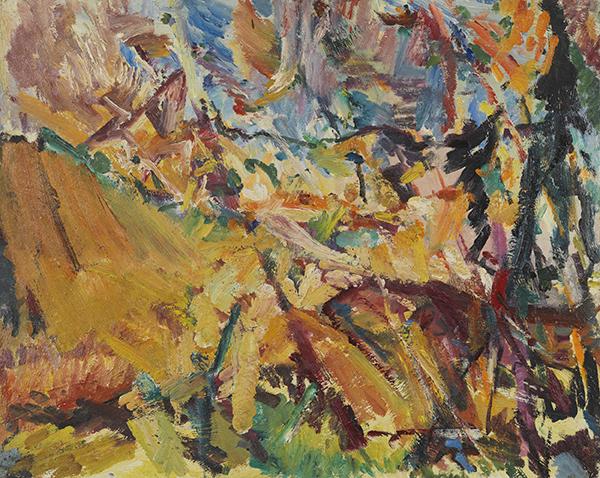Messum’s are holding a survey exhibition of Miles Richmond’s work at their Cork Street gallery in Mayfair. Happily the show coincides with a number of other exhibitions relating to Richmond’s fellow artists from the Borough Group, who studied under the direction of David Bomberg at the Borough Polytechnic on London’s South Bank in the late 1940s. Waterhouse & Dodd’s current show, David Bomberg and his students at the Borough Polytechnic, runs until October 24, while James Hyman’s exhibition, Dennis Creffield: Paintings of Innocence and Experience, closes on October 30.
The cumulative effect of this series – headlined by the Tate’s six-month-long current Frank Auerbach show – is to focus attention back on one of the most experimental and creative periods in post-war British art. Messum’s, who have also commissioned a film for their exhibition, find themselves with perhaps the most intriguingly eclectic of Bomberg’s former students. Indeed, during Bomberg’s final years in southern Spain, Richmond alone enjoyed a deep friendship with his former teacher.
Such was their connection that Richmond even suffered a crisis of identity, at one time unable to tell where Bomberg’s work ended and his own began. It drove him to abandon painting for a time, taking up his brushes once more only when he identified a new personal direction. In his twenties, he frequented the same Soho haunts as Lucian Freud, and recalled Quentin Crisp as a favourite model. But Richmond’s vision was above all inspired by Cézanne and he became obsessed by what he saw as the sixth sense, the ability to look beyond form and shape for the spirit and energy of a place.
To this end he eventually stopped drawing lines altogether, substituting colour blocks to create shape, tone and mood in his semi-abstract and abstract landscapes. As such, his technique and working philosophy provides keys to unlocking many of the profound abstractions in contemporary and modern art that continue to confound even the most dedicated viewer.
The artist’s landscapes have been described as ‘afterimages’ – the impression left on the retina when closing your eyes after being caught in the glare of a bright light. They can also be seen as heat maps, tracing the energy of a view rather than its topographical contours. This obsession developed from an early age when Richmond was still at school. He avoided art lessons because of the monotony of repeating the same composition, line by line, until the teacher was satisfied, and instead focused on physics and chemistry.
Richmond was fascinated by science in general but especially by Einstein and quantum theory, as well as what it meant for the way we perceive objects, matter and space. And his art reflects this interest as he breaks down the barriers of the five senses to reach through to the physical world at the quantum level. To him, painting meant realising the energy given off by the particles that make up objects, “the life-giving energy that exists beyond the conscious mind”, or what Bomberg called “the spirit in the mass”.
Richmond’s 1999 commission, London from the South Bank, a mural painted while atop the roof of London South Bank University (previously Borough Polytechnic), eschews the topographical layout of the city below in favour of a scientific assessment, described as an exercise in spectroscopy, the study of the interrelation between matter and its radiant energy. When it came to landscape or people and animals, Richmond focused on capturing the spirit and energy of a place rather than studiously noting down its topography.
The theory is an extension of William Blake’s visionary work, just as Richmond’s Red Studio reverie echoes Coleridge’s interrupted trance when writing Kublai Khan. And this idea of intelligent nature, with a life-giving energy or force just beyond the reach of our five physical senses, coincides with the Romantics’ vision as part of the Enlightenment. This explains what Richmond meant when he said: “When I first saw Cézanne it was like the skin dropped off my eyes.”
Miles Richmond: Art Beyond The Senses – Messum’s Cork Street Gallery – until 7 November 2015

